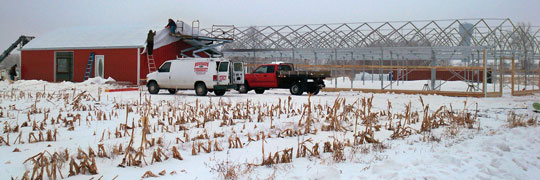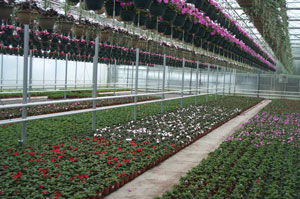2/21/2011
Building on Success
Jennifer Zurko
During our travels to different growers,
GrowerTalks always asks, “So, what’s new?” And lately, the answer has revolved around either the construction of new greenhouses, improvements on current facilities, or even new purchases of existing structures at another location.
You may be thinking, “How could they afford to add on in this economical climate? We couldn’t even begin to consider that.” But as you’ll see, these three growers were still able to build and/or improve after scrutinizing and taking the time to research what was best for their particular operation … even if the pay-off wasn’t immediate.
The Green Spot
Dave and Janet Schmock just couldn’t squeeze any more plants in the small 900-sq.ft. seasonal building they’ve been using for growing selling for the last five years. “It was tough. I grew the material over in Waterloo [Iowa] and then I’d purchase that wholesale and then I’d have to transport it at night,” said Dave. “It just got to the point where we were pulling quite a few all-nighters.”
Since 2009, sales have doubled at The Green Spot, allowing the Schmocks to build a 14,000-sq. ft. greenhouse at their Manchester, Iowa, location, using it for production and as a retail area. The extra space was great, but it didn’t come without its challenges.
“We got used to operating out of that little 900-sq. ft. building,” Dave recalls. “Everything had to be in order and neat and tidy. When we put this facility up, it was soon discovered that everything has to be ready for sale. And it has to be customer-friendly and that’s kind of the way we put it together—with wide aisles and how we merchandise things.”
So the Schmocks not only had to find a structure that would provide the ideal environment for their crops, but also one that was aesthetically pleasing to the end-consumers at the same time. Once the greenhouse (supplied by Canada-based Harnois Industries) was built with a double-poly roof, they placed red tin siding on the outside to make it look more like a barn than a greenhouse. Inside, Dave and Janet used inexpensive 1 ft. x 12 ft. pine planking to simulate a barn’s interior. “So, it’s dressed up,” says Dave. “It’s got a floor and we have the ability to display things. It came out really nice.”
And their customers are pleased with it, too. Dave explained that their retail traffic has been increasing quite rapidly even before the addition—so much so that they’re escalating their production this year because they sold out of 3,000 hanging baskets by June 15 last summer. With customers coming from as far south as Cedar Rapids and Dyersville to the east, the focus on continuing to provide quality plants and customer service was one of the driving forces behind the decision to add on, said Dave. Plus, because they have more space, they’ve been able to sign on some wholesale customers this year.
For the greenhouse itself, including the roof and heat, Dave estimates the price was about $58,000. But there are a lot of other details that come into building a new facility on your property that aren’t in the forefront of many growers’ minds.
“We invested a lot of money in just getting the site level,” said Dave. “You can look at the area—which used to be a corn field—and it looks really level, until you put a transit on it. That’s your basics: your water, your electricity hook-up, your phone and then getting the site level. Those are major expenses that you know are going to be there, but you don’t expect them to be as bad as they are. You really have to investigate that.”

Here are some of Dave’s suggestions for growers who are considering adding a facility:
- “The main thing I would suggest—especially if you’re in the city limits—is to make sure you examine all your costs as far as the zoning and municipalities are concerned. That is one item that will sneak up on you.”
- “Contact three to four different greenhouse suppliers and work with a sales rep that you’re comfortable with. It means a lot if you know the person you’re buying from and it takes a lot of stress out of the whole experience.”
- “Be upfront and honest with your suppliers. It’s amazing how much information and assistance you can get from them even in a slow economy.”
- “Location of course is key; building in a community where you grew up or are familiar with and have personal ties to. Being an asset to your community helps you get the support from the community.”
- “Many of us in the industry grew up in it and have ties to currently running greenhouses or retired greenhouse owners. Chances are pretty good they’ll have equipment that can be refurbished, supplies, or odds and ends that can be used to complete the project. Not everything has to be new. Christiensen’s Greenhouse in Dubuque, Iowa, was owned by Jim Christiensen, who’s now retired and saved everything. Jim and Joe Christiensen played a huge roll in the successful completion of our project. If you know anyone like this, consider yourself fortunate.”
Norman Keil Nurseries
When we visited Norman, Sr. and Norman, Jr., owners of Norman Keil Nurseries in St. James, New York, last April, much of the conversation focused on recent improvements and additions. While standing in their newly constructed 60,000 sq. ft. of Apex greenhouses from Westbrook Greenhouse Systems, Norman, Jr. told us how they were not only planning on replacing their aging Quonsets, but they also invested in some new automation. And all of this after a disappointing 2009 season, which Norman said was their worst year ever.
That didn’t prevent them from looking ahead. After a better 2010, father and son are currently overseeing the construction of another new Apex house that is scheduled to be completed later this year. All of these improvements have to be made in order for them to stay at the forefront of a very competitive Long Island market.
“We’ll continue to upgrade our existing structures, as well as expand, as long as we can continue to provide the quality and service to our customers,” said Norman, Jr. “We don’t need to build and build to satisfy our egos or become over-leveraged. We’re building so that we can service our customers as best as possible and to drive sales.”

The new Apex greenhouse at Norman Keil Nurseries offers an extra 60,000 sq. ft. of space for growing hundreds of hanging baskets and any size pot.
Actually, Norman Keil Nurseries has been improving or building new structures steadily since 1999. Norman says he doesn’t think they’ve taken a season off without building something.
The 60,000 sq. ft. that was built in 2006 is used for larger combination containers (mostly 16-, 14- and 12-in.) and includes a boom irrigation system from Zwart Systems that’s designed to water directly into each pot regardless of size. Norman, Jr. explained it helps them save on time and gives them the ability to grow any size container their customer wants. Plus, all the space allows them to get three turns of large pots for the spring, along with a late summer crop of annuals and poinsettias later in the year.
When it comes to working out the costs versus the return, Norman, Jr. says they’re still figuring out not only the investment in the new house in St. James, but the ½-acre open-roof house at their Mattituck location and ¼-acre of new Quonsets at the Setauket farm. Even if the numbers come up a little short, the fact that the business continues to grow is what counts, says Norman, Jr.
“For us, we needed to upgrade our growing areas to stay in business,” he stated. “We were inefficient in all areas and had to start rebuilding old sections, as well as building new sections at different farms to keep up with the major changes our industry has experienced in the last 10 years. I don’t see us stopping.”
Cavicchio Greenhouses
This 100-year-old greenhouse operation has been growing steadily since Paul Cavicchio, Jr.’s grandparents emigrated from Italy and opened the business as an apple orchard in Sudbury, Massachusetts, in 1910. Even after Cavicchio Greenhouses was destroyed by the Great New England Hurricane of 1938 (they didn’t start naming hurricanes until after the 1950s), the Cavicchios bounced back, changing their product offering to include vegetables and then eventually bedding plants. Now, Cavicchio Greenhouses is a 200-acre wholesale business providing annuals, perennials, nursery stock and landscape supplies to garden centers and landscapers.
On Mother’s Day Weekend in 2010, 2 acres of greenhouses went up in flames after a tractor inside the facility caught on fire. Every plant and every inch of greenhouse was completely destroyed, so Paul had to replace 2 acres of growing space in a very short amount of time. Space is a priceless commodity at Cavicchio Greenhouses, which is why it was imperative that they rebuild as soon as possible.

Cavicchio Greenhouses in Sudbury, Massachusetts, had to rebuild 2 acres of greenhouses after losing the previous facilities in a fire.
“My problem is I’m running out of room,” said Paul. “I know I have 200 acres, but every inch of that land is filled with something making money, so it’s kind of hard to take away from one crop to add to
another.”
The materials for a 2-acre state-of-the-art ebb-and-flow Westbrook glass house were assembled using local labor in time to produce the hundreds of annuals and poinsettias Cavicchio’s offers. (To learn more about the TrueFlow
subirrigation system in Cavicchio’s new greenhouses, turn to page 54.) With everything included—the structure, ebb-and-flow floors, floor heating and natural ventilation—Paul figures the new house cost about $40 per sq. ft.
If it wasn’t for the fire, Paul said he “would have had the original house for 20 years without touching it.” But he does feel building and improving is a great investment for any grower—depending on the situation.
“It’s always good to continuously improve your business, but it all depends on the circumstances of any grower, large or small,” he said. “You can be very efficient with these gutter-connected houses and heat curtains and computer-operated systems to make growing a lot easier. But a small grower might already have all that and doesn’t need to grow any further. It’s circumstance by circumstance.”
GT